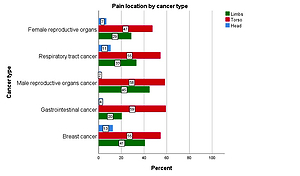Current issue
Archive
Manuscripts accepted
About the Journal
Editorial office
Editorial board
Section Editors
Abstracting and indexing
Subscription
Contact
Ethical standards and procedures
Most read articles
Instructions for authors
Article Processing Charge (APC)
Regulations of paying article processing charge (APC)
PSYCHOLOGY / CLINICAL RESEARCH
Qualitative analysis of pain in cancer patients – psychological and clinical aspects
1
Department of Psychology and Medical Communication, Medical University of Warsaw, Poland
2
Maria Sklodowska-Curie National Research Institute of Oncology, Poland
3
Department of Social Medicine and Public Health, Doctoral School, Medical University of Warsaw, Poland
4
Department of Psycho-oncology, Maria Sklodowska-Curie National Research Institute of Oncology, Warsaw, Poland
5
Dialog Therapy Centre, Warsaw, Poland
6
Department of Cancer & Cardio-Oncology Diagnostics, Maria Sklodowska-Curie National Research Institute of Oncology, Warsaw, Poland
Submission date: 2021-10-04
Final revision date: 2022-08-16
Acceptance date: 2022-09-08
Online publication date: 2022-10-03
Corresponding author
Agata Ciuba
Maria Sklodowska-Curie National Research Institute of Oncology, 5 Roentgena Str., 02-781, Warszawa, Poland
Maria Sklodowska-Curie National Research Institute of Oncology, 5 Roentgena Str., 02-781, Warszawa, Poland
KEYWORDS
TOPICS
ABSTRACT
Introduction:
Cancer pain is a serious medical problem affecting about 75% of patients. As the disease progresses, the percentage of those suffering from pain increases. On the whole, cancer pain is one of the most common symptoms accompanying the disease and the symptom that patients fear the most. Pain, and even the awareness that it may occur, affects a person’s mood and modifies their health behavior, and may lead to changes in the treatment process. The perception of pain in cancer patients is sometimes so great and long-lasting that it disorganizes the patient’s life, making it impossible for them to function even on a basic level and degenerating the patient’s psyche.
Material and methods:
The study was carried out on 661 patients of the Pain Treatment Clinic in the years 2016–2019. The survey was conducted using standardized tools – Melzack’s qualitative pain questionnaire and an 11-point numerical rating scale (NRS).
Results:
Moderate and severe pain intensity was reported by 90% of interviewed patients, who required immediate modification of the current treatment and implementation of additional adjuvant drugs. Almost 50% of them reported constant pain with varying severity.
Conclusions:
Pain is not only a medical problem, but also a clinical, psychological, and socio-economic issue. Its multidimensional nature affects patients’ functioning and quality of life. Therefore, it has to be properly diagnosed and treated like a disease itself.
Cancer pain is a serious medical problem affecting about 75% of patients. As the disease progresses, the percentage of those suffering from pain increases. On the whole, cancer pain is one of the most common symptoms accompanying the disease and the symptom that patients fear the most. Pain, and even the awareness that it may occur, affects a person’s mood and modifies their health behavior, and may lead to changes in the treatment process. The perception of pain in cancer patients is sometimes so great and long-lasting that it disorganizes the patient’s life, making it impossible for them to function even on a basic level and degenerating the patient’s psyche.
Material and methods:
The study was carried out on 661 patients of the Pain Treatment Clinic in the years 2016–2019. The survey was conducted using standardized tools – Melzack’s qualitative pain questionnaire and an 11-point numerical rating scale (NRS).
Results:
Moderate and severe pain intensity was reported by 90% of interviewed patients, who required immediate modification of the current treatment and implementation of additional adjuvant drugs. Almost 50% of them reported constant pain with varying severity.
Conclusions:
Pain is not only a medical problem, but also a clinical, psychological, and socio-economic issue. Its multidimensional nature affects patients’ functioning and quality of life. Therefore, it has to be properly diagnosed and treated like a disease itself.
Share
RELATED ARTICLE
We process personal data collected when visiting the website. The function of obtaining information about users and their behavior is carried out by voluntarily entered information in forms and saving cookies in end devices. Data, including cookies, are used to provide services, improve the user experience and to analyze the traffic in accordance with the Privacy policy. Data are also collected and processed by Google Analytics tool (more).
You can change cookies settings in your browser. Restricted use of cookies in the browser configuration may affect some functionalities of the website.
You can change cookies settings in your browser. Restricted use of cookies in the browser configuration may affect some functionalities of the website.



